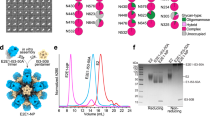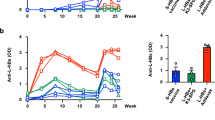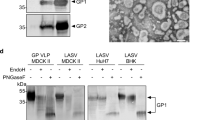Abstract
A formalin-inactivated hepatitis B virus (HBV) vaccine has been produced in several laboratories (for review, see ref. 1). The sole source of material for these vaccines has been 22-nm lipoprotein particles composed of hepatitis B surface antigen (HBsAg) and derived from plasma of persons chronically infected with HBV. Such a source presents potential hazards in view of unknown factors that may be present in the plasma, and as high-risk populations are immunized, sources of plasma containing large quantities of HBsAg will become scarce. In addition, no tissue culture system has been developed for the propagation of HBV. The possibility of a synthetic peptide vaccine2,3 for HBV had been suggested2,3 following studies carried out with tobacco mosaic virus4,5 and MS-2 coliphage6. This possibility recently became a reality when the amino acid sequence for HBsAg was deduced from the nucleotide sequence of the cloned HBV genome (for a review, see ref. 7). More recently a portion of the major polypeptide derived from HBsAg, with a calculated molecular weight of 25,000 (P25), has been sequenced8. Lerner et al.9 have described a similar approach towards HBV synthetic peptides. Antibody to HBsAg (anti-HBs) was raised in rabbits inoculated with three or four doses of a series of peptides, each containing 14–15 amino acid residues, but only after covalent linkage of the peptides to a carrier protein. Activity was also found after multiple injections of a peptide containing 34 amino acids. We have now synthesized two cyclic peptides containing disulphide bonds, both unrelated to those prepared by Lerner, from a hydrophilic region of the major viral polypeptide, which elicited an antibody response in mice after a single injection without linkage to a protein carrier.
This is a preview of subscription content, access via your institution
Access options
Subscribe to this journal
Receive 51 print issues and online access
$199.00 per year
only $3.90 per issue
Buy this article
- Purchase on Springer Link
- Instant access to full article PDF
Prices may be subject to local taxes which are calculated during checkout
Similar content being viewed by others
References
McAuliffe, V. J., Purcell, R. H. & Gerin, J. L. Rev. infect. Dis. 2, 470–492 (1980).
Rae, K. R. & Vyas, G. N. Nature new Biol. 241, 240–241 (1973).
Melnick, J. L., Dreesman, G. R. & Hollinger, F. B. J. infect. Dis. 133, 210–229 (1976).
Anderer, F. A. Biochim. biophys. Acta 71, 246–248 (1963).
Fearney, F. J., Leung, C. Y., Young, J. D. & Benjamini, E. Biochim. biophys. Acta 243, 509–514 (1971).
Langbeheim, H., Arnon, R. & Sela, M. Proc. natn. Acad. Sci. U.S.A. 73, 4636–4640 (1976).
Tiollais, P., Charnay, P. & Vyas, G. N. Science 213, 406–411 (1981).
Peterson, D. L. J. biol. Chem. 256, 6975–6983 (1981).
Lerner, R. A. et al. Proc. natn. Acad. Sci. U.S.A. 78, 3403–3407 (1981).
Chou, P. Y. & Fasman, G. D. Adv. Enzym. 47, 45–148 (1978).
Bull, H. B. & Breese, K. Archs Biochem. Biophys. 161, 665–670 (1975).
Atassi, M. Z. Immunochemistry 12, 423–438 (1975).
Merrifield, R. B. Adv. Enzym. 32, 221–296 (1969).
Edelstein, M. S., McNair, D. S. & Sparrow, J. T. in Peptides: Synthesis, Structure, Function (eds Rich, D. H. & Gross, E.) (Pierce Chemical Co., Rockford, in the press).
Sparrow, J. T. J. org. Chem. 41, 1350–1353 (1976).
Atherton, E., Woolley, V. & Sheppard, R. C. JCS chem. Commun., 970 (1981).
Mao, S. J. T., Sparrow, J. T., Gilliam, E. B., Gotto, A. M. & Jackson, R. L. Biochemistry 16, 4150–4156 (1977).
Felix, A. M., Jiminez, M. H., Wang, C. T. & Meienhofer, J. Int. J. Peptide Protein Res. 15, 342–354 (1980).
Dreesman, G. R., Hollinger, F. B., Sanchez, Y., Oefinger, P. & Melnick, J. L. Infect. Immun. 32, 62–67 (1981).
Sanchez, Y. et al. Infect. Immun. 30, 728–733 (1980).
Dixon, W. J. & Brown, M. B. BMDP-79 (University of California Press, Berkeley, 1979).
Hollinger, F. B., Adam, E., Heiberg, D. & Melnick, J. L. in Viral Hepatitis (eds Alter, H., Maynard, J. & Szmuness, W.) (Franklin Institute Press, Philadelphia, in the press).
Fudenberg, H. H. & Kunkel, H. G. J. exp. Med. 106, 689–702 (1957).
Vyas, G. N. in Hepatitis B Vaccine (eds Maupas, P. & Guesry, P.) (Elsevier, Amsterdam, 1981).
Hopp, T. P. & Woods, K. R. Proc. natn. Acad. Sci. U.S.A. 78, 3824–3828 (1981).
Author information
Authors and Affiliations
Rights and permissions
About this article
Cite this article
Dreesman, G., Sanchez, Y., Ionescu-Matiu, I. et al. Antibody to hepatitis B surface antigen after a single inoculation of uncoupled synthetic HBsAg peptides. Nature 295, 158–160 (1982). https://doi.org/10.1038/295158a0
Received:
Accepted:
Issue Date:
DOI: https://doi.org/10.1038/295158a0
This article is cited by
-
New dimensions in vaccinology: A new insight
Indian Journal of Clinical Biochemistry (2005)
-
Multi‐epitope DNA vaccines
Immunology & Cell Biology (1997)
-
Antigenic analysis of bean pod mottle virus using linear and cyclized synthetic peptides
Archives of Virology (1993)
-
Protein antigenicity
Molecular Biology Reports (1992)
Comments
By submitting a comment you agree to abide by our Terms and Community Guidelines. If you find something abusive or that does not comply with our terms or guidelines please flag it as inappropriate.



